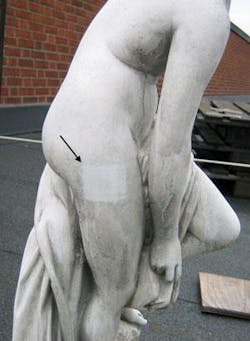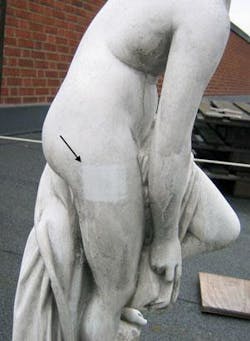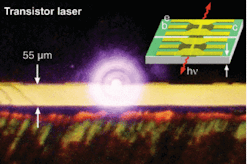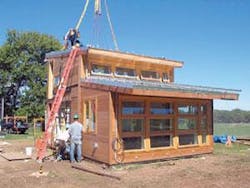Temporal superresolution introduced for ultrashort laser pulses
Analogous to imposing a mask on the instrument pupil of a microscope to achieve optical superresolution for imaging subheadsystems, scientists at Ecole Polytechnique (Palaiseau, France) have used spectral phase masks to shape a laser pulse into a central peak of very short duration below the Fourier-limited width of Gaussian pulses, accompanied by low-intensity satellite pulses. Just as the low-level wings that accompany the Airy pattern of the imaging microscope are suppressed by nonlinear detection methods, the low-intensity satellite pulses of the laser can be suppressed by strong nonlinear phenomena in laser-matter interactions.
The phenomena was demonstrated using a 1-kHz Ti:sapphire chirped-pulse-amplified laser system emitting 30-fs full-width-at-half-maximum (FWHM)-duration, 814-nm pulses. An acousto-optic programmable filter inserted between the pulse stretcher and the regenerative amplifier was used as the superresolving mask. By modifying the phase-mask parameters, the researchers reduced the pulse duration of the central peak to only 19-fs FWHM, with satellite subheadpulses reaching an arbitrary intensity of 0.4 compared to 1.0 for the central peak. These wings can be suppressed by a subheadnumber of methods, including the application of more-complex phase masks or by nonlinear effects such as four-wave mixing in photonic crystals. Contact Olga Boyko at [email protected].
Remote-imaging LIBS cleans far-off objects
Scientists in the Atomic Physics Division of the Lund Institute of Technology (Lund, Sweden) have demonstrated remote-imaging laser-induced breakdown spectroscopy (LIBS) and its use in remote ablative cleaning of stone surfaces.
The remote-imaging LIBS was accomplished by focusing frequency-tripled 355-nm radiation from a 20-Hz pulsed Nd:YAG laser on a target 60 m away using a 10-cm-diameter refractive telescope placed coaxially with a receiving 40-cm diameter reflective Newtonian telescope. The transmission and receiving beam paths are folded using a rooftop 40 × 80-cm first-surface aluminized mirror controlled by stepper motors to scan across the target image. The telescope design focuses the laser to a calculated 0.7-mm (measured 5-mm) focal-spot diameter, sufficient to induce a plasma breakdown at the target. Collected plasma light was used to provide a false-color coded identification image of a series of metal plates, as an example of remote LIBS spectra analysis. In addition, effective remote laser ablation of surface accumulations was demonstrated on a number of stone objects and statues, eliminating the need for expensive scaffolding. Contact Rasmus Grönlund at [email protected].
Fiber Laser Forum debuts at Photonics West
Fiber lasers and their potential in commercial, industrial, and medical markets will be the focus of several talks at the annual Laser and Photonics Marketplace Seminar, to be held Jan. 23, 2006, at the Fairmont Hotel in San Jose, CA, in conjunction with Photonics West. In addition to the keynote address, “Value Added Manufacturing in the Laser Industry,” to be given by Phillip Meredith, general manager of JDS Uniphase Laser Products (San Jose, CA), the first half of the seminar will feature detailed analyses of sales and technology trends in the global laser market, semiconductor laser market, industrial market, and medical market.
The afternoon will be devoted to the Fiber Laser Markets Forum, chaired by Andrew Brown, director of business development at Aculight (Bothell, WA). The forum will bring together industry experts to present a series of perspectives on the current and future market potential of fiber lasers. Presentations will include Fiber Laser Technology Review by Andy Held, VP of marketing, Nufern; Markets and Applications for Low-Power Fiber Lasers by Stuart Woods, VP of business development, Southampton Photonics; Markets and Applications for High-Power Fiber Lasers by Bill Shiner, director, industrial market development, IPG Photonics Corp.; Markets and Applications for Single Frequency Fiber Lasers by Pat Edsell, president and CEO, NP Photonics; and Government Markets and Applications for Fiber Lasers by Don D. Seeley, Army Representative, High Energy Laser Joint Technology Office, Space and Missile Defense Command, U.S. Army. For more information, see www.marketplaceseminar.com.
New optical fiber breaks effective-mode-diameter limit
Fiber nonlinear effects that limit the peak power of fiber lasers can be overcome by using optical fibers with a large effective mode area, so scientists have been subheadexperimenting with different fiber designs that meet this criterion and can still support single-mode propagation. Currently, intermode coupling in conventional fibers used as single-mode but that support a few modes limits the mode-field diameter (MFD) to approximately 30 µm, while single-mode propagation in photonic-crystal fibers is limited to a MFD of approximately 28 µm. In both cases, the fibers are weak waveguides that are highly sensitive to bending and environmental effects.
In what they are calling a breakthrough after five to seven years of stagnation in the development of large-effective-area fiber, scientists at IMRA America (Ann Arbor, MI) have designed a silica-glass fiber with very large air holes outside the solid core that provides sufficient mode filtering to support single-mode propagation and displays subheadnegligible loss at bending diameters as small as 15 cm. Physical measurement of the subheadfiber’s output intenssubheadity profile, as well as numerical simulations, resulted in a measured MFD of approximately 42.5 µm. Contact subheadLiang Dong at [email protected].
Room-temperature bipolar-transistor laser advances
Transistor lasers capable of operating at room temperature could facilitate faster signal processing, large-capacity seamless communications, and higher-performance electrical and optical integrated circuits. In fact, room-temperature operation is critical for large-scale commercial applications of transistor lasers. Building on previous research involving heterojunction bipolar transistors that produced a bipolar transistor operating at 600 GHz, researchers at the University of Illinois (Urbana-Champaign) have demonstrated room-temperature (25°C) operation of a heterojunction bipolar transistor laser (HBTL) at 3 GHz with simultaneous electrical gain.
The indium gallium phosphide/gallium arsenide (InGaP/GaAs) laser features aluminum gallium arsenide optical confining layers and an InGaAs recombination quantum well incorporated into the p-type base region; according to the researchers, the base region carrier recombination can be modified and improved with quantum wells and a reflecting cavity, thereby yielding a direct laser modulation of an 850-µm-long edge-emitting HBTL with a 2.2-µm-wide emitter. Because the current iteration of this experimental device operates at much lower current densities than the greater-than-500-GHz heterojunction bipolar transistors now possible, they expect the transistor laser to eventually achieve much higher speeds. Contact Milton Feng at [email protected].
Tiny force limits practical size of nanodevices
Researchers at the University of Arizona (Tucson, AZ) have measured for the first time, to their knowledge, the de Broglie wave phase shift caused by atom-surface interactions. The tiny force, caused by the polarization of atoms in fluctuating electromagnetic fields that results in a long-range attraction between electrically neutral matter-the van der Waals interaction-subheadlimits the extent to which an atom optics subheaddevice (such as an atom interferometer) can be miniaturized before the force causes quantum incoherence that can disrupt subheadoperations.
Using an atom interferometer, a phase shift of 0.3 radians was measured for subheadsodium (Na) atoms passing subheadwithin 25 nm of a surface for 75 ps. The van der Waals interaction thus places a limit on the subheadspatial scale of atom interferometers built on a chip because bringing the subheadatoms too close to the surface can result in poor contrast. Contact Alexander Cronin at [email protected].
Vertical-cavity surface-emitting laser yields tunable ultraslow light
Researchers at the subheadUniversity of California-Berkeley and subheadTexas A&M University (College subheadStation, TX) have operated a subheadvertical-subheadcavity surface-emitting laser (VCSEL) as a Fabry-Perot amplifier to demonstrate tunable group delays of broadband optical signals at room temperature. Slow-light demonstrations to date have tended to rely on material or waveguide dispersion, according to the researchers, which generally limits maximum achievable delay-bandwidth product along with suitability for applications in broadband communications.
By varying the bias subheadcurrent of a 1.55-µm VCSEL around lasing threshold, the research team achieved continuously tunable delays of up to 100 ps for an incoming broadband signal with a modulation frequency of 2.8 GHz. The current experiment focused on controlling gain in the VCSEL active region while remaining within the Fabry-Perot amplifier regime. The researchers expect to achieve increased delays by pushing the system to the point of injection locking. They also expect that the technique will prove scalable, both for delays over several modulation periods, and to larger tunable delays and higher bandwidth signals through the use of multiwavelength VCSEL arrays. Contact Connie J. Chang-Hasnain at [email protected].
Nobel Prize in physics awarded to three optics researchers
This year’s Nobel Prize in physics was awarded to three scientists in the field of optics. Roy Glauber of Harvard University (Cambridge, MA) was awarded half the prize for his quantum-mechanical theory of optical coherence, while John Hall of JILA (a collaboration between the University of Colorado and the National Institute of Standards and Technology, both of Boulder, CO) and Theodor Hänsch of the Max Planck Institute for Quantum Optics (Garching, Germany) jointly won the other half for their development of optical frequency-measurement techniques, which include the use of optical frequency combs.
Glauber established the basis of quantum optics, including the quantum-mechanical theory of photon statistics, which helps describe fluctuations in the numbers of photons in coherent and incoherent light beams. He is also studying the statistics of free-atom beams. In 1978, Hänsch and his group discovered that modelocked lasers emit their modes at equidistant frequencies as a frequency comb. Hall and Hänsch pursued the frequency-comb phenomenon, developing ultrafast-laser systems to create frequency combs with very large spectral spans (see Laser Focus World, July 2001, p. 38, and October 2005, p. 26). Such combs can be used in ultraprecise clocks, and may help keep the Global Positioning System in time. See www.kva.se.
Crystalline/amorphous photovoltaics combine with fuel cell in solar house
Photovoltaic (PV) cells as a very large-scale source of electrical power are not yet practical, in part because sunshine is inconstant. Directly injecting PV output into the power grid works only if PV power remains a minor (and thus nondisruptive) portion of total electrical power output. Widespread PV use, on the other hand, would require enormous amounts of energy-storage hardware. Electrolysis-produced hydrogen (H2) is one potential energy-storage medium.
Researchers and students at the New York Institute of Technology (Old Westbury, NY) have done their part to bring the two technologies together by building an 800-sq-ft house, “Green Machine/Blue Space” (shown here partially disassembled for transport), that is powered by PV cells and a fuel cell that runs on PV-produced H2. The PV cells, which produce 10.8 kW in full sun and are manufactured by Sanyo Electric (Tokyo, Japan), have a crystalline and two amorphous-silicon layers to boost efficiency. An electrolyzer from Proton Energy Systems (Wallingford, CT) produces 100 ft3 of H2 per 15 to 18 kWh; a 5-kW fuel cell from Plug Power (Latham, NY) completes the setup. The house was exhibited at the subheadSolar Decathlon (Oct. 6-16 on the National Mall, Washington, D.C.). Contact Paul Koch at [email protected].



